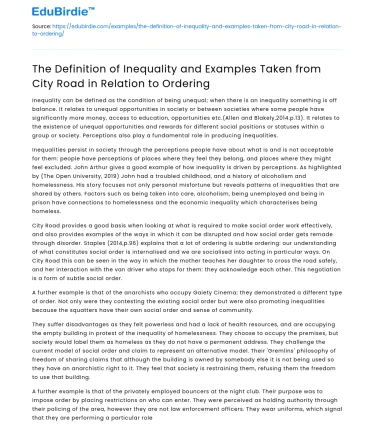Inequality can be defined as the condition of being unequal; when there is an inequality something is off balance. It relates to unequal opportunities in society or between societies where some people have significantly more money, access to education, opportunities etc.(Allen and Blakely,2014.p.13). It relates to the existence of unequal opportunities and rewards for different social positions or statuses within a group or society. Perceptions also play a fundamental role in producing inequalities.
Inequalities persist in society through the perceptions people have about what is and is not acceptable for them: people have perceptions of places where they feel they belong, and places where they might feel excluded. John Arthur gives a good example of how inequality is driven by perceptions. As highlighted by (The Open University, 2019) John had a troubled childhood, and a history of alcoholism and homelessness. His story focuses not only personal misfortune but reveals patterns of inequalities that are shared by others. Factors such as being taken into care, alcoholism, being unemployed and being in prison have connections to homelessness and the economic inequality which characterises being homeless.
Save your time!
We can take care of your essay
- Proper editing and formatting
- Free revision, title page, and bibliography
- Flexible prices and money-back guarantee
City Road provides a good basis when looking at what is required to make social order work effectively, and also provides examples of the ways in which it can be disrupted and how social order gets remade through disorder. Staples (2014,p.96) explains that a lot of ordering is subtle ordering: our understanding of what constitutes social order is internalised and we are socialised into acting in particular ways. On City Road this can be seen in the way in which the mother teaches her daughter to cross the road safely, and her interaction with the van driver who stops for them: they acknowledge each other. This negotiation is a form of subtle social order.
A further example is that of the anarchists who occupy Gaiety Cinema; they demonstrated a different type of order. Not only were they contesting the existing social order but were also promoting inequalities because the squatters have their own social order and sense of community.
They suffer disadvantages as they felt powerless and had a lack of health resources, and are occupying the empty building in protest of the inequality of homelessness. They choose to occupy the premises, but society would label them as homeless as they do not have a permanent address. They challenge the current model of social order and claim to represent an alternative model. Their 'Gremlins' philosophy of freedom of sharing claims that although the building is owned by somebody else it is not being used so they have an anarchistic right to it. They feel that society is restraining them, refusing them the freedom to use that building.
A further example is that of the privately employed bouncers at the night club. Their purpose was to impose order by placing restrictions on who can enter. They were perceived as holding authority through their policing of the area, however they are not law enforcement officers. They wear uniforms, which signal that they are performing a particular role in terms of ordering whilst they work. However this could be perceived as an inequality: the students felt that they were being judged on their age and appearance. They felt unequal because they may not be able to afford the sort of clothes required; losing this right over what they can wear demonstrates how their personal equality has been removed. (Blakeley and Staples, 2014,p.88). Although students feel that the bouncers like to act intimidating and that they think they are above everyone else, they usually accept their decisions, see they are necessary as they increase safety, and are there to kick drunk people out. This is a good example of how social order is maintained in drinking premises. The use of bouncers can enforce good behaviour but can also be resented.
In conclusion, this essay has defined inequality and has highlighted that John, the bouncers and the anarchists are all examples of ordering in City Road. It has demonstrated that there are many different ways in which ordering takes place, some of which are assumed and some of which are more observable, such as the activities of the bouncers. It has highlighted the variation in perceptions of order and disorder. Order can be maintained in different ways: through monitoring peoples behaviour, through laws and regulations, through the use of material objects to encourage or restrict particular behaviours such as; traffic light systems, and by encouraging people to monitor themselves. Different interpretations of order can result from differing perceptions of what is considered orderly or disorderly behaviour and these are influenced by factors such as sexuality, race, gender, age, ethnicity and class.






 Stuck on your essay?
Stuck on your essay?

